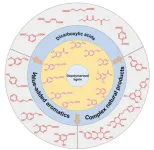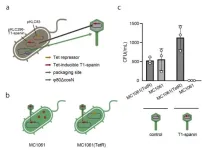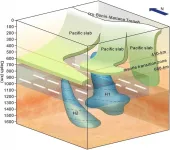(Press-News.org)
Lignin is an abundant natural polymer which is eliminated as a byproduct in the pulp and paper industry. A recent review article explored different microbial processes available for sustainable lignin valorization, yielding not only environmental, but also economic benefits. Researchers highlighted the current advancements as well as challenges faced while using naturally occurring and engineered microbes to transform depolymerized lignin into valuable high-value products.
The increasing focus on transitioning to a low-carbon society has driven research towards developing sustainable solutions. Lignin, a natural polymer that is abundantly found in plant biomass, is traditionally discarded as a byproduct in the pulp and paper industry or burnt as fuel. However, in recent times it has emerged as a valuable feedstock for producing various eco-friendly value-added products.
The most used lignin transformation method employs a two-stage strategy involving depolymerization followed by refining to transform lignin into beneficial products. Various pretreatment strategies and depolymerization techniques, including oxidative, reductive, and thermal depolymerization, and chemical modification, decompose lignin into lower weight phenolic compounds, which were then refined into specialized and high-value chemicals. Moreover, lignin utilization can be maximized by using microbes capable of degrading lignin-derived aromatics into value-added products. Certain bacterial and fungal species such as Pseudomonas putida, Rhodococcus opacus, Rhodopseudomonas palustris, Phanerochaete chrysosporium, and Sphingomonas possess enzymes that enable them to directly utilize pretreated lignin or depolymerized aromatic compounds. Additionally, the expression of heterologous enzymes in model microorganisms like Escherichia coli allowed the transformation of lignin-based platform compounds into more valuable end products.
In a recent study, Professor Jianqiang Fan from the Technology Center, China Tobacco Fujian Industrial Co. Ltd. collaborated with Professor Zheyong Xue from Northeast Forestry University, Professor Anqi Chen from Jiangnan University, and Professor Jifeng Yuan from Xiamen University, to review the current progress in biological strategies for upcycling lignin using microbes. Their study was published in Volume 6 of BioDesign Research on January 22, 2024. Elaborating on the purpose of their study, Professor Jifeng Yuan explains, “Furthermore, our review provides insights into the problems facing current biological lignin valorization while proposing further research directions to improve these technologies for the extensive accomplishment of the lignin upcycling.”
The article highlighted the promising production of dicarboxylic acids, particularly cis, cis-muconic acid (ccMA), from lignin. Traditional methods involved chemical synthesis from petroleum-based raw materials, but synthetic biology offered an eco-friendly alternative. Engineered strains of bacteria like P. putida, E. coli, and Amycolatopsis sp. were used to optimize the ccMA synthetic pathways, thereby synthesizing increased quantities ccMA from lignin-derived compounds. The researchers also discussed the use of engineered strains of P. putida and E. coli to synthesize adipic acid, a commercially important dicarboxylic acid, pyridine-dicarboxylic acids and beta-ketoadipate from lignin hydrolysates.
The study further explained the use of microbial biocatalysis for synthesizing vanillin from lignin-derived ferulic acid and the effective production of gallic acid through microbial fermentation of lignin-derived compounds. The review also explored the improved biosynthesis of phenolic acids (like 4-hydroxyphenylacetic acid and 3,4-dihydroxyphenylacetic acid) and complex natural products including phenolic glycosides, coumarins, and flavonoids from lignin-derived compounds, using engineered microbial strains.
The researchers emphasized the simplicity and sustainability of direct processing of lignocellulosic hydrosylates by microbes into various molecules. They observed that lignin-degrading bacteria are widely distributed in natural lignin-rich diverse environments, and mainly belong to the phyla Proteobacteria, Actinobacteria, Firmicutes, and Archaea.
In conclusion, this study underscores the potential of harnessing microbes for sustainable lignin valorization, recognizing lignin’s potential as a renewable feedstock. The interdisciplinary approach aligns with global goals for a circular and sustainable bioeconomy, emphasizing the importance of microbiology, chemistry, synthetic biology, and genetic engineering in unlocking the full potential of lignin for high-value chemical production. A hopeful Professor Yuan concludes, “The effective use of lignin can drastically increase the cost-effectiveness of the lignocellulosic biorefinery, leading to a more sustainable and circular economy.”
###
References
Journal: BioDesign Research
Titles of original papers: Microbial Upcycling of Depolymerized Lignin into Value-Added Chemicals
DOI: https://doi.org/10.34133/bdr.0027
END
Given the worldwide prevalence of drug-resistance bacteria, the research fraternity is on the lookout for alternative bactericidal treatment approaches. In a recent study, Japanese researchers have now compared bacteriophage-derived enzymes for combating drug-resistant bacteria. Examination of T1-spanin revealed that it shows superior bactericidal activity against various strains, including E.coli. Furthermore, a novel phage-based technology effectively delivers T1-spanin genes into target bacteria. This breakthrough holds promise for the development of ...
From anxiety about the state of the world to ongoing waves of Covid-19, the stresses we face can seem relentless and even overwhelming. Worse, these stressors can cause chronic inflammation in our bodies. Chronic inflammation is linked to serious conditions such as cardiovascular disease and cancer – and may also affect our thinking and behavior.
A new hypothesis published in Frontiers in Science suggests the negative impacts may extend far further.
“We propose that stress, ...
LAWRENCE, KANSAS — A University of Kansas study of rice paddy snakes in Southeast Asia gives key details to their diversification and natural history, adding molecular evidence that the rise of the Khorat Plateau and subsequent environmental shifts in Thailand may have altered the course of the snakes’ evolution some 2.5 million years ago. The findings were published today in the journal Scientific Reports.
Researchers say the implications could help tell the story of diversification more broadly in the region.
“This paper concerns mud snakes ...
Scientists from the Universities of Sydney and Sorbonne University have used the geological record of the deep sea to discover a connection between the orbits of Earth and Mars, past global warming patterns and the speeding up of deep ocean circulation.
They discovered a surprising 2.4-million-year cycle where deep currents wax and wane which, in turn, is linked to periods of increased solar energy and a warmer climate.
The study, published in Nature Communications, tackles the questions of how geological-timescale climate ...
If you had to estimate the number of people in a room, without counting them one-by-one, by nature you would overcount them. That’s because, simply put from a Darwinian perspective of how we have evolved, it’s better to overcount potentially harmful agents and predators than to underestimate them. This overcounting social behaviour is shown to be true in humans as well as animals. It’s certainly better to detect too many tigers (even if absent) during a jungle excursion than to miss a hungry one!
Now, EPFL neuroscientists show that if you experience hallucinations, especially ...
Researchers from China and Japan have discovered distinct characteristics of the lower mantle flow field. They investigated seismic anisotropy in the upper part of the lower mantle beneath the Philippine Sea Plate (PSP) and found that the ancient lower mantle flow field is still preserved there.
The study was published in Nature Geoscience.
The lower mantle is an important layer of the Earth and may play an important role in the evolution and material cycling of Earth's interior. It is generally believed to be not only the final destination of subducted slabs, ...
*EMBARGOED UNTIL TUESDAY, MARCH 12, AT 6 A.M. ET
Age-related changes that cause the skin to stiffen and become less elastic may also contribute to higher rates of metastatic skin cancer in older people, according to research by investigators from the Johns Hopkins Kimmel Cancer Center.
The study, published March 12 in Nature Aging, shows that increased stiffness in aging skin increases the release of a protein called ICAM1. Increased ICAM1 levels stimulate blood vessel growth in the tumor, helping it grow. It also makes the blood vessels “leaky,” enabling tumor cells ...
Despite being scattered across more than a million square kilometres, new research has revealed that remote coral reefs across the Seychelles are closely related. Using genetic analyses and oceanographic modelling, researchers at Oxford University demonstrated for the first time that a network of ocean currents scatter significant numbers of larvae between these distant islands, acting as a ‘coral superhighway.’ These results are published today in Scientific Reports.
Dr April Burt (Department of Biology, University of Oxford, and Seychelles Islands Foundation), lead author of the study, said: ‘This discovery is very important because a key factor ...
CAMBRIDGE, MA -- Tumors can carry mutations in hundreds of different genes, and each of those genes may be mutated in different ways — some mutations simply replace one DNA nucleotide with another, while others insert or delete larger sections of DNA.
Until now, there has been no way to quickly and easily screen each of those mutations in their natural setting to see what role they may play in the development, progression, and treatment response of a tumor. Using a variant of CRISPR genome-editing known as prime editing, MIT researchers have ...
Rainforest seedlings are more likely to survive in natural forests than in places where logging has happened – even if tree restoration projects have taken place, new research shows.
Scientists monitored over 5,000 seedlings for a year and a half in North Borneo.
They studied a landscape containing both natural forest and areas logged 30 years ago – some of which were recovering naturally, while some had been restored by methods including tree planting.
A drought had triggered “mast fruiting” across ...










